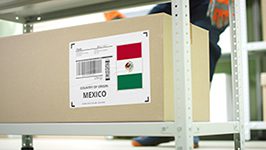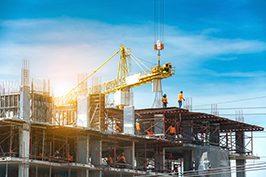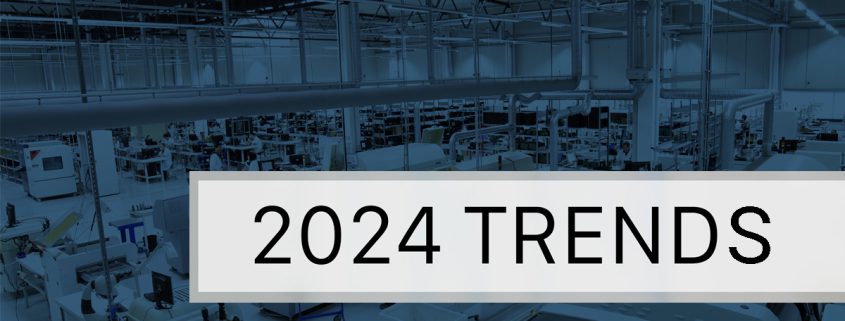Industrial Trends for 2024: Part 1 – National Markets
It’s no secret to observers of the industrial market that, following a torrid couple of years that saw vacancy rates plunge to all-time lows and asset pricing soar to all-time highs, there has finally been a return to something closer to normalcy. While the pricing of industrial properties has not yet come down appreciably, vacancy rates have returned to pre-pandemic levels, mainly due to record levels of construction — much of it built on spec. It is worth noting, however, that pre-pandemic vacancy levels (around 5%) were at then-record lows, so tenants across the country seeking to relocate, renew, or expand will still be facing sticker shock in 2024 following double-digit annual rental rate increases since 2020.
Although Voit Real Estate Services focuses primarily on the Southern California markets, we decided to start with a big-picture view of the national markets. We scoured the reports and aggregated opinions from a wide range of sources, including NAR, Commercial Edge, CoStar, and global brokerage houses. Here’s what we can expect in 2024 and beyond from the industrial market:
The Numbers
Vacancy: After a year in which year-over-year net absorption went down 57% to 178.3 million square feet, according to NAR, the national vacancy rate crept up steadily during 2023 and crossed 5% for the first time since the start of the pandemic. According to most estimates, vacancy currently sits around 5%–5.5% and is expected to continue to rise to approximately 6.5% through 2024. However, this is still far below historical lows, as the U.S. industrial vacancy rate averaged around 8% from 1995 to 2019.

Construction: In addition to a decrease in demand and economic uncertainty in 2023, one of the primary drivers behind the increase in vacancy rates was the unprecedented levels of new industrial construction. Following a year (2022) in which approximately 600 million square feet of industrial product was delivered, an additional 300-400 million was completed in 2023 — with another 500 million square feet under construction through November. Much of that spec construction was big-box warehouse distribution facilities, and it is estimated that approximately 400 million square feet of those spec projects are unleased, driving up the vacancy rates. Construction starts slowed to a 10-year low in the second half of the year, due to that decrease in demand and rising interest rates. In the near term, many developers are focusing on build-to-suit projects and specialty facilities like cold storage and manufacturing (more on that later).
Rental Rates: While the increase in vacancy would appear to be good news for tenants, that doesn’t seem to be the case. National in-place rents for industrial space averaged $7.60 per square foot in November of 2023, up 7.7% year-over-year, and the average for leases signed in 2023 was $10.26, according to Commercial Edge. Even with the projected rise in vacancy, rates will remain high, although rental growth will be slower in most markets (predicted to be 6.5% to 7.5%). Moody’s Analytics forecasts annual rent growth for warehouse and distribution properties will consistently track at approximately 5% to 6% for the next ten years.
Property Sales: According to Yardi Matrix data, industrial sales totaled $48.6 billion through the end of November, down significantly from the $88.3 billion in industrial transactions during 2022. Properties traded at $130 per square foot (psf) nationally, holding steady from last year’s $132 psf but miles above the $83 psf in 2019. Not surprisingly, Los Angeles County and the Inland Empire were number 1 and 2 in sales volume, each with nearly $4 billion in sales, far ahead of the #3 market, Dallas, at $2.7 billion. California properties also topped the list in price per square foot, with the Bay Area leading the nation at $336 psf, followed by Los Angeles County ($315) and Orange County ($309).
What’s Coming in 2024 and Beyond
As previously noted, construction starts for warehouse and distribution facilities slowed significantly in the second half of 2023, but as e-commerce continues to grow as a percentage of all retail sales (15.6% up from 14.8% at the close of 2022) and interest rates begin to fall, the consensus is that construction starts will pick up again. However, the most significant impact on industrial construction in the coming years will likely come from the emergence of nearshoring and reshoring of manufacturing in the U.S.

The breakdowns in the global supply chain that started with COVID-19 has U.S. manufacturers returning operations to North America, as the fragility of long supply chains was exposed and the risk of geopolitical friction with China has grown. Mexico’s expanding manufacturing base has offered an alternative to producing in China. As evidence of the nearshoring trend, our Southern neighbor has edged ahead of China in 2023 as the country’s number-one trade partner. Mexico’s export volume at the close of 2023 was 15.5% compared to China’s 15%.

According to the Wall Street Journal and other sources, the reshoring surge is the government’s response to the supply chain disruptions. The Infrastructure Investment and Jobs Act (IIJA), the Creating Helpful Incentives to Produce Semiconductors (CHIPS) and Science Act, and the Inflation Reduction Act (IRA) are all spurring investment in American manufacturing. Real manufacturing construction spending has doubled from the end of 2021 until June 2022 and has only increased. The boom is principally driven by construction for computer, electronic, and electrical manufacturing – which used to be a relatively small share of manufacturing construction over the past few decades but are now dominant components. Since the beginning of 2022, real spending on construction for those specific types of manufacturing has nearly quadrupled, according to the U.S. Treasury.

While nearshoring and onshoring require a long process still in its early stages, the U.S. government has provided billions in green energy investment in solar photovoltaic panel plants, electric vehicles, and battery plants, and should keep the U.S. is on track to becoming the global leader in advanced manufacturing in the next 5-10 years, creating security for U.S. supply chains.
Cold Storage: This niche industrial asset class is expected to more than double by 2030. Vacancy is limited in most markets, with rates typically lower than standard warehouse distribution facilities (in the 3% to 4% range). There is essentially no vacancy in some large cold storage markets, so the development of cold storage facilities is expected to increase in 2024, including spec construction.
Conclusion
The industrial sector, despite an increase in vacancy and a temporary slowdown in new construction starts, is still a favored commercial real estate class among investors and should remain that way through the remainder of the decade.
In an upcoming post, we’ll drill down on the specific Southern California industrial markets, with our senior brokers providing boots-on-the-ground insights into their particular markets and links to our 2023 Q4 market reports. For additional information on how Voit Real Estate Services can help you make informed real estate decisions, visit our Services page.









